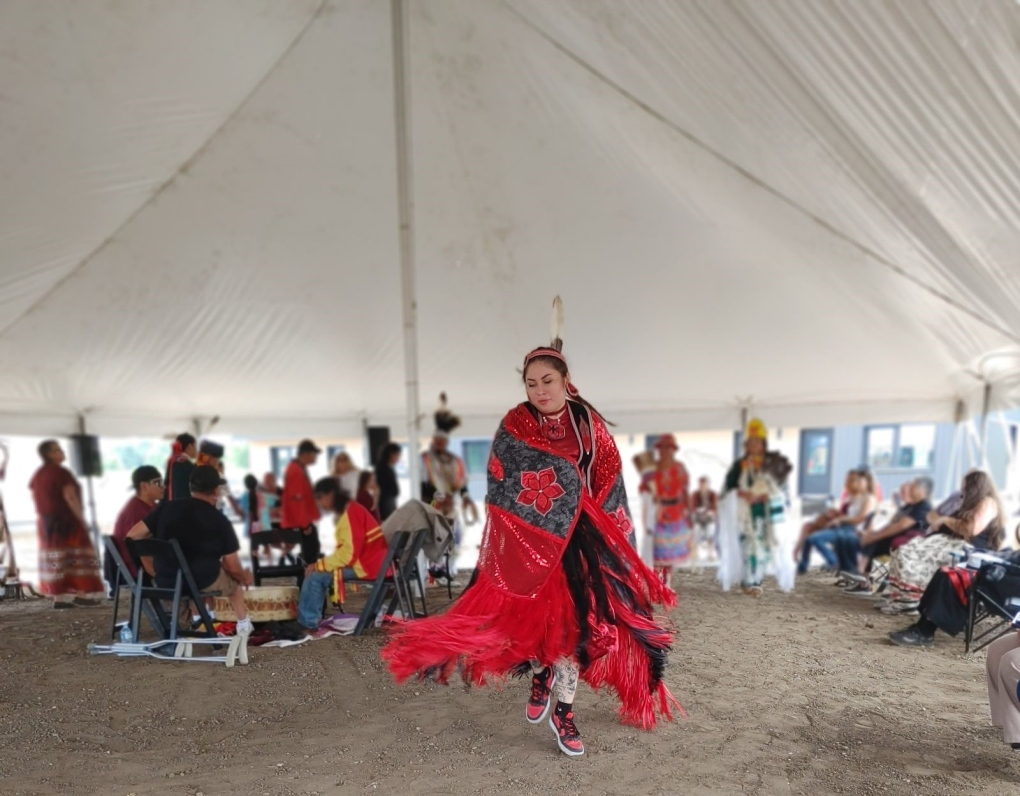Caldwell First Nation reclaims territory with new homes
Members of the Caldwell First Nation are celebrating a return to their ancestral territory.
Drumming and singing was heard in the community during the historic Land Back cultural celebration Saturday as the rain poured, cleansing the historic moment.
“We had a beautiful day with Sunrise Ceremony at 6 a.m. and we moved into being able to have dancers and drummers and share food, share our stories and there were a lot of tears today with our community,” said Chief Mary Duckworth of Caldwell First Nation.
“I think seeing rain come in after we are just wrapping up is really a cleansing feeling and really refreshing. It’s good for us. The rain is good.”
In Indigenous culture, water is a source of life, according to the Native Women’s Association of Canada.
As it poured down, Chief Duckworth and Larry Johnson, councillor and former Chief, rejoiced.
“This is a celebration of a historical nature,” said Johnson. “We may do this every year. I’m looking forward to a future powwow, set up a baseball diamond, and maybe a shooting range for our hunters to practice. There are so many ideas and so many projects on the way.”
 A dancer during the Grand Entry on Aug. 17, 2024. (Source: Caldwell First Nation)
A dancer during the Grand Entry on Aug. 17, 2024. (Source: Caldwell First Nation)
The people of the community were removed and worked to maintain relationships with their families, language, ways of living and relationship with nature for 235 years.
According to a media release, in May 1790, the Ottawa, Chippewa, Pottawatomi and Huron surrendered a big area of land in southwestern Ontario. That included Point Pelee.
“Caldwell First Nation did not sign or benefit from the treaty,” it said. “In consideration of our service in the War of 1812, we were promised land at Point Pelee.”
“We continued our way of life on our lands and Point Pelee for 40 years after the war, with the support of the Canadian government, until the late 1850s when settler squatters occupied our lands and we were driven off the land.”
It continued, adding the food stores and homes of the community were burned and RCMP on horseback used whips to disperse them.
“We lost our sense of community and physical landscape. We were blocked from harvesting plants and hunting fish and animals, holding gatherings and accessing our sacred cultural heritage sites.”
According to census records from the 1850s to the 1870s, the Anishinaabe people were said to be living in Mersea Township in Leamington and in Essex and Kent counties.
The community became known as the Caldwell First Nation after fighting with Tecumseh and other First Nations as allies of the British. They fought to save the shores.
“It took years of strong leadership and enduring obstacles on our path home,” said Chief Duckworth.
“If not for our ancestors and leaders, we would not be standing here on our land now. In ceremonies, songs and stories, and most of all through our nationhood, we are sharing our gratitude to the Creator and to all who have come before us and contributed to saving our nation and creating a new homeland.”
As the day garnered national attention, Chief Duckworth hopes this will have an impact on other First Nations communities.
“The impact on other First Nations communities I feel is coming together with fellowship, sharing ideas, sharing information,” she said.
“Caldwell First Nation has good relationships with the First Nations and talking to them and working with them has really helped us get to where we are.”
“I hope to have those continued relationships so that we are able to come together again and be successful all together.”
CTVNews.ca Top Stories

Prime Minister Trudeau meets Donald Trump at Mar-a-Lago
Prime Minister Justin Trudeau landed in West Palm Beach, Fla., on Friday evening to meet with U.S.-president elect Donald Trump at Mar-a-Lago, sources confirm to CTV News.
'Mayday! Mayday! Mayday!': Details emerge in Boeing 737 incident at Montreal airport
New details suggest that there were communication issues between the pilots of a charter flight and the control tower at Montreal's Mirabel airport when a Boeing 737 made an emergency landing on Wednesday.
Hit man offered $100,000 to kill Montreal crime reporter covering his trial
Political leaders and press freedom groups on Friday were left shell-shocked after Montreal news outlet La Presse revealed that a hit man had offered $100,000 to have one of its crime reporters assassinated.
Questrade lays off undisclosed number of employees
Questrade Financial Group Inc. says it has laid off an undisclosed number of employees to better fit its business strategy.
Cucumbers sold in Ontario, other provinces recalled over possible salmonella contamination
A U.S. company is recalling cucumbers sold in Ontario and other Canadian provinces due to possible salmonella contamination.
Billboard apologizes to Taylor Swift for video snafu
Billboard put together a video of some of Swift's achievements and used a clip from Kanye West's music video for the song 'Famous.'
Musk joins Trump and family for Thanksgiving at Mar-a-Lago
Elon Musk had a seat at the family table for Thanksgiving dinner at Mar-a-Lago, joining President-elect Donald Trump, Melania Trump and their 18-year-old son.
John Herdman resigns as head coach of Toronto FC
John Herdman, embroiled in the drone-spying scandal that has dogged Canada Soccer, has resigned as coach of Toronto FC.
Weekend weather: Parts of Canada could see up to 50 centimetres of snow, wind chills of -40
Winter is less than a month away, but parts of Canada are already projected to see winter-like weather.


































